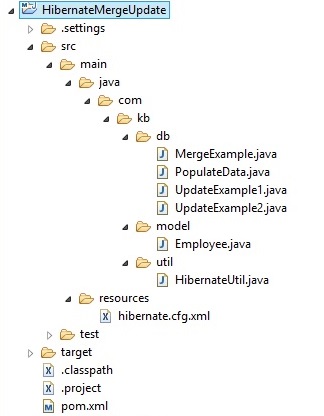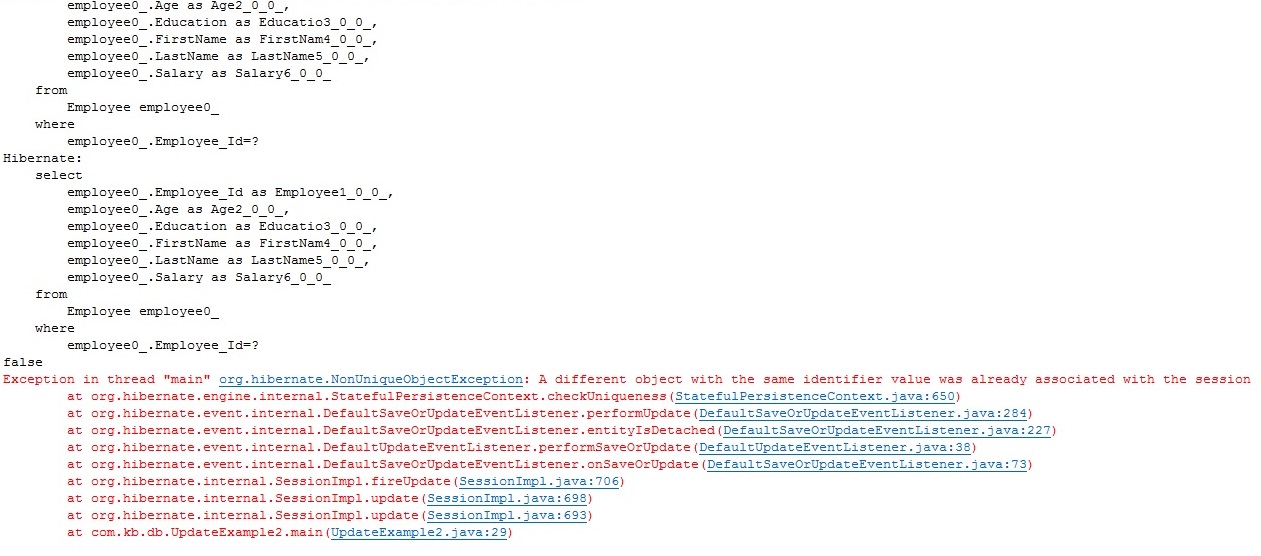Merge vs Update in Hibernate with example
- 20th Apr 2017
- 0
- 17725
- Difference Between Merge And Update Methods In Hibernate Difference Between Update and Merge methods In Hibernate Difference between update vs merge in Hibernate example Hibernate Session merge Merge vs update clear difference Merge vs Update in Hibernate with example update what is the difference between merge and update in hibernate when to use merge over update in hibernate
Let us understand Merge and Update in Hibernate
The most important and frequently asked question in Hibernate is the difference between merge and update methods and often we can notice that developers use update() and merge() methods alternatively.
Let’s understand the use of merge() and update() methods with example
We know that both merge() and update() methods are used to update the entity and can also change the state of an object(from detached to persistent state).
Please read this article to know about different states of an object in Hibernate.
But there is a subtle difference between update() and merge() methods.
The difference is update() method can not be used when the same object already exist in the session whereas merge() method can be used.
Lets see how update() method works with example

When we call update() method, if the same object is not exist in session cache then the update() method will update the object.
When we call update() method, if the same object is already exist in session cache then the update() method throws an exception called “NonUniqueObjectException”.
Lets see how merge() method works with example

Similar to update() method, merge() method also changes the state of detached state to persistent state.
When we call merge() method, It first checks the same object exist in cache
If exist then it will update the cache with the changes, else if object is not exist in cache then it will load the values to cache.
So in either way,unlike update() method, merge() method will not throw any exception.
Let’s understand merge() and update() with sample project
Step 1
Create hibernate project
Please refer Hibernate setup in eclipse article on how to do it.
Project structure

Step 2
Update pom.xml with Hibernate and Mysql dependencies
- <project xmlns="http://maven.apache.org/POM/4.0.0" xmlns:xsi="http://www.w3.org/2001/XMLSchema-instance"
- xsi:schemaLocation="http://maven.apache.org/POM/4.0.0 http://maven.apache.org/xsd/maven-4.0.0.xsd">
- <modelVersion>4.0.0</modelVersion>
- <groupId>HibernateMergeUpdate</groupId>
- <artifactId>HibernateMergeUpdate</artifactId>
- <version>0.0.1-SNAPSHOT</version>
- <packaging>jar</packaging>
- <name>HibernateMergeUpdate</name>
- <url>http://maven.apache.org</url>
- <properties>
- <project.build.sourceEncoding>UTF-8</project.build.sourceEncoding>
- </properties>
- <dependencies>
- <dependency>
- <groupId>junit</groupId>
- <artifactId>junit</artifactId>
- <version>3.8.1</version>
- <scope>test</scope>
- </dependency>
- <dependency>
- <groupId>org.hibernate</groupId>
- <artifactId>hibernate-core</artifactId>
- <version>5.2.6.Final</version>
- </dependency>
- <!-- https://mvnrepository.com/artifact/mysql/mysql-connector-java -->
- <dependency>
- <groupId>mysql</groupId>
- <artifactId>mysql-connector-java</artifactId>
- <version>6.0.5</version>
- </dependency>
- </dependencies>
- </project>
<project xmlns="http://maven.apache.org/POM/4.0.0" xmlns:xsi="http://www.w3.org/2001/XMLSchema-instance"
xsi:schemaLocation="http://maven.apache.org/POM/4.0.0 http://maven.apache.org/xsd/maven-4.0.0.xsd">
<modelVersion>4.0.0</modelVersion>
<groupId>HibernateMergeUpdate</groupId>
<artifactId>HibernateMergeUpdate</artifactId>
<version>0.0.1-SNAPSHOT</version>
<packaging>jar</packaging>
<name>HibernateMergeUpdate</name>
<url>http://maven.apache.org</url>
<properties>
<project.build.sourceEncoding>UTF-8</project.build.sourceEncoding>
</properties>
<dependencies>
<dependency>
<groupId>junit</groupId>
<artifactId>junit</artifactId>
<version>3.8.1</version>
<scope>test</scope>
</dependency>
<dependency>
<groupId>org.hibernate</groupId>
<artifactId>hibernate-core</artifactId>
<version>5.2.6.Final</version>
</dependency>
<!-- https://mvnrepository.com/artifact/mysql/mysql-connector-java -->
<dependency>
<groupId>mysql</groupId>
<artifactId>mysql-connector-java</artifactId>
<version>6.0.5</version>
</dependency>
</dependencies>
</project>
Step 3
Create Employee class
- package com.kb.model;
- import javax.persistence.Column;
- import javax.persistence.Entity;
- import javax.persistence.GeneratedValue;
- import javax.persistence.GenerationType;
- import javax.persistence.Id;
- import javax.persistence.Table;
- @Entity
- @Table(name="Employee")
- public class Employee {
- @Id
- @GeneratedValue(strategy = GenerationType.SEQUENCE)
- @Column(name = "Employee_Id")
- private int employeeId;
- @Column(name = "FirstName")
- private String firstName;
- @Column(name = "LastName")
- private String lastName;
- @Column(name = "Age")
- private int age;
- @Column(name = "Education")
- private String education;
- @Column(name = "Salary")
- private int salary;
- public int getEmployeeId() {
- return employeeId;
- }
- public void setEmployeeId(int employeeId) {
- this.employeeId = employeeId;
- }
- public String getFirstName() {
- return firstName;
- }
- public void setFirstName(String firstName) {
- this.firstName = firstName;
- }
- public String getLastName() {
- return lastName;
- }
- public void setLastName(String lastName) {
- this.lastName = lastName;
- }
- public int getAge() {
- return age;
- }
- public void setAge(int age) {
- this.age = age;
- }
- public String getEducation() {
- return education;
- }
- public void setEducation(String education) {
- this.education = education;
- }
- public int getSalary() {
- return salary;
- }
- public void setSalary(int salary) {
- this.salary = salary;
- }
- }
package com.kb.model;
import javax.persistence.Column;
import javax.persistence.Entity;
import javax.persistence.GeneratedValue;
import javax.persistence.GenerationType;
import javax.persistence.Id;
import javax.persistence.Table;
@Entity
@Table(name="Employee")
public class Employee {
@Id
@GeneratedValue(strategy = GenerationType.SEQUENCE)
@Column(name = "Employee_Id")
private int employeeId;
@Column(name = "FirstName")
private String firstName;
@Column(name = "LastName")
private String lastName;
@Column(name = "Age")
private int age;
@Column(name = "Education")
private String education;
@Column(name = "Salary")
private int salary;
public int getEmployeeId() {
return employeeId;
}
public void setEmployeeId(int employeeId) {
this.employeeId = employeeId;
}
public String getFirstName() {
return firstName;
}
public void setFirstName(String firstName) {
this.firstName = firstName;
}
public String getLastName() {
return lastName;
}
public void setLastName(String lastName) {
this.lastName = lastName;
}
public int getAge() {
return age;
}
public void setAge(int age) {
this.age = age;
}
public String getEducation() {
return education;
}
public void setEducation(String education) {
this.education = education;
}
public int getSalary() {
return salary;
}
public void setSalary(int salary) {
this.salary = salary;
}
}
We have specified Primary key as employeeId and generator class as “sequence” for automatic primary key generation.
Step 4
Create hibernate.cfg.xml
- <?xml version="1.0" encoding="UTF-8"?>
- <!DOCTYPE hibernate-configuration PUBLIC
- "-//Hibernate/Hibernate Configuration DTD 3.0//EN"
- "http://www.hibernate.org/dtd/hibernate-configuration-3.0.dtd">
- <hibernate-configuration>
- <session-factory>
- <!-- Database connection properties -->
- <property name="connection.driver_class">com.mysql.jdbc.Driver</property>
- <property name="connection.url">jdbc:mysql://localhost/javainsimpleway</property>
- <property name="connection.username">root</property>
- <property name="connection.password">root</property>
- <!-- JDBC connection pool (using the built-in) -->
- <property name="connection.pool_size">100</property>
- <!-- SQL dialect -->
- <property name="dialect">org.hibernate.dialect.MySQLDialect</property>
- <!-- Disable the second-level cache -->
- <property name="cache.provider_class">org.hibernate.cache.internal.NoCacheProvider</property>
- <!-- Echo all executed SQL to stdout -->
- <property name="show_sql">true</property>
- <!-- Format the generated Sql -->
- <property name="format_sql">true</property>
- <!-- Dont Drop and re-create the database schema on startup,Just update
- it -->
- <property name="hbm2ddl.auto">update</property>
- <mapping class="com.kb.model.Employee" />
- </session-factory>
- </hibernate-configuration>
<?xml version="1.0" encoding="UTF-8"?>
<!DOCTYPE hibernate-configuration PUBLIC
"-//Hibernate/Hibernate Configuration DTD 3.0//EN"
"http://www.hibernate.org/dtd/hibernate-configuration-3.0.dtd">
<hibernate-configuration>
<session-factory>
<!-- Database connection properties -->
<property name="connection.driver_class">com.mysql.jdbc.Driver</property>
<property name="connection.url">jdbc:mysql://localhost/javainsimpleway</property>
<property name="connection.username">root</property>
<property name="connection.password">root</property>
<!-- JDBC connection pool (using the built-in) -->
<property name="connection.pool_size">100</property>
<!-- SQL dialect -->
<property name="dialect">org.hibernate.dialect.MySQLDialect</property>
<!-- Disable the second-level cache -->
<property name="cache.provider_class">org.hibernate.cache.internal.NoCacheProvider</property>
<!-- Echo all executed SQL to stdout -->
<property name="show_sql">true</property>
<!-- Format the generated Sql -->
<property name="format_sql">true</property>
<!-- Dont Drop and re-create the database schema on startup,Just update
it -->
<property name="hbm2ddl.auto">update</property>
<mapping class="com.kb.model.Employee" />
</session-factory>
</hibernate-configuration>
We have defined all the database configuration in this file
hbm2ddl.auto property is defined in the config file which helps in automatic creation of tables in the database based on the mapping.
We have also provided the mapping class name using “mapping” tag.
Step 5
Create Hibernate util class
- package com.kb.util;
- import org.hibernate.SessionFactory;
- import org.hibernate.cfg.Configuration;
- public class HibernateUtil {
- private static final SessionFactory sessionFactory = buildSessionFactory();
- private static SessionFactory buildSessionFactory() {
- try {
- // Create the SessionFactory from hibernate.cfg.xml
- return new Configuration().configure().buildSessionFactory();
- } catch (Throwable ex) {
- // Make sure you log the exception to track it
- System.err.println("SessionFactory creation failed." + ex);
- throw new ExceptionInInitializerError(ex);
- }
- }
- public static SessionFactory getSessionFactory() {
- return sessionFactory;
- }
- public static void shutdown() {
- // Optional but can be used to Close caches and connection pools
- getSessionFactory().close();
- }
- }
package com.kb.util;
import org.hibernate.SessionFactory;
import org.hibernate.cfg.Configuration;
public class HibernateUtil {
private static final SessionFactory sessionFactory = buildSessionFactory();
private static SessionFactory buildSessionFactory() {
try {
// Create the SessionFactory from hibernate.cfg.xml
return new Configuration().configure().buildSessionFactory();
} catch (Throwable ex) {
// Make sure you log the exception to track it
System.err.println("SessionFactory creation failed." + ex);
throw new ExceptionInInitializerError(ex);
}
}
public static SessionFactory getSessionFactory() {
return sessionFactory;
}
public static void shutdown() {
// Optional but can be used to Close caches and connection pools
getSessionFactory().close();
}
}
Step 6
Create PopulateData.java file to Populate Employee Table with initial data
- package com.kb.db;
- import org.hibernate.Session;
- import org.hibernate.SessionFactory;
- import org.hibernate.Transaction;
- import com.kb.model.Employee;
- import com.kb.util.HibernateUtil;
- public class PopulateData {
- public static void main(String[] args) {
- // Get session factory using Hibernate Util class
- SessionFactory sf = HibernateUtil.getSessionFactory();
- // Get session from Sesson factory
- Session session = sf.openSession();
- // Begin transaction
- Transaction t = session.beginTransaction();
- //Create Employee data
- Employee employee1 = new Employee();
- employee1.setFirstName("John");
- employee1.setLastName("KC");
- employee1.setAge(28);
- employee1.setEducation("PG");
- employee1.setSalary(25000);
- Employee employee2 = new Employee();
- employee2.setFirstName("Jacob");
- employee2.setLastName("JC");
- employee2.setAge(30);
- employee2.setEducation("PG");
- employee2.setSalary(30000);
- Employee employee3 = new Employee();
- employee3.setFirstName("Martin");
- employee3.setLastName("A");
- employee3.setAge(24);
- employee3.setEducation("UG");
- employee3.setSalary(20000);
- Employee employee4 = new Employee();
- employee4.setFirstName("Peter");
- employee4.setLastName("M");
- employee4.setAge(25);
- employee4.setEducation("UG");
- employee4.setSalary(22000);
- Employee employee5 = new Employee();
- employee5.setFirstName("Roshan");
- employee5.setLastName("B");
- employee5.setAge(29);
- employee5.setEducation("PG");
- employee5.setSalary(45000);
- session.save(employee1);
- session.save(employee2);
- session.save(employee3);
- session.save(employee4);
- session.save(employee5);
- // Commit the transaction and close the session
- t.commit();
- session.close();
- System.out.println("successfully persisted Employee details");
- }
- }
package com.kb.db;
import org.hibernate.Session;
import org.hibernate.SessionFactory;
import org.hibernate.Transaction;
import com.kb.model.Employee;
import com.kb.util.HibernateUtil;
public class PopulateData {
public static void main(String[] args) {
// Get session factory using Hibernate Util class
SessionFactory sf = HibernateUtil.getSessionFactory();
// Get session from Sesson factory
Session session = sf.openSession();
// Begin transaction
Transaction t = session.beginTransaction();
//Create Employee data
Employee employee1 = new Employee();
employee1.setFirstName("John");
employee1.setLastName("KC");
employee1.setAge(28);
employee1.setEducation("PG");
employee1.setSalary(25000);
Employee employee2 = new Employee();
employee2.setFirstName("Jacob");
employee2.setLastName("JC");
employee2.setAge(30);
employee2.setEducation("PG");
employee2.setSalary(30000);
Employee employee3 = new Employee();
employee3.setFirstName("Martin");
employee3.setLastName("A");
employee3.setAge(24);
employee3.setEducation("UG");
employee3.setSalary(20000);
Employee employee4 = new Employee();
employee4.setFirstName("Peter");
employee4.setLastName("M");
employee4.setAge(25);
employee4.setEducation("UG");
employee4.setSalary(22000);
Employee employee5 = new Employee();
employee5.setFirstName("Roshan");
employee5.setLastName("B");
employee5.setAge(29);
employee5.setEducation("PG");
employee5.setSalary(45000);
session.save(employee1);
session.save(employee2);
session.save(employee3);
session.save(employee4);
session.save(employee5);
// Commit the transaction and close the session
t.commit();
session.close();
System.out.println("successfully persisted Employee details");
}
}
In this class, we are persisting 5 Employee records
Step 7
Lets Create Main class to perform Update and Merge operations
UpdateExample1.java
- package com.kb.db;
- import org.hibernate.Session;
- import org.hibernate.SessionFactory;
- import org.hibernate.Transaction;
- import com.kb.model.Employee;
- import com.kb.util.HibernateUtil;
- public class UpdateExample1 {
- public static void main(String[] args) {
- // Get session factory using Hibernate Util class
- SessionFactory sf = HibernateUtil.getSessionFactory();
- // Get session from Session factory
- Session session1 = sf.openSession();
- // Load the Employee details whose Id is 1
- Employee employee = (Employee) session1.get(Employee.class, new Integer(1));
- session1.close();
- //Update employee object, which is in detached state
- employee.setAge(45);
- Session session2 = sf.openSession();
- Transaction tx = session2.beginTransaction();
- session2.update(employee);
- tx.commit();
- }
- }
package com.kb.db;
import org.hibernate.Session;
import org.hibernate.SessionFactory;
import org.hibernate.Transaction;
import com.kb.model.Employee;
import com.kb.util.HibernateUtil;
public class UpdateExample1 {
public static void main(String[] args) {
// Get session factory using Hibernate Util class
SessionFactory sf = HibernateUtil.getSessionFactory();
// Get session from Session factory
Session session1 = sf.openSession();
// Load the Employee details whose Id is 1
Employee employee = (Employee) session1.get(Employee.class, new Integer(1));
session1.close();
//Update employee object, which is in detached state
employee.setAge(45);
Session session2 = sf.openSession();
Transaction tx = session2.beginTransaction();
session2.update(employee);
tx.commit();
}
}
In this program, we are updating the age to 45 for an employee whose id is 1.
In this program, employee object in detached state is attached again to session to make it persistent and cache will not have the object with same id
Hence update will be successful in this case.
Create UpdateExample2.java
- package com.kb.db;
- import org.hibernate.Session;
- import org.hibernate.SessionFactory;
- import org.hibernate.Transaction;
- import com.kb.model.Employee;
- import com.kb.util.HibernateUtil;
- public class UpdateExample2 {
- public static void main(String[] args) {
- // Get session factory using Hibernate Util class
- SessionFactory sf = HibernateUtil.getSessionFactory();
- // Get session from Session factory
- Session session1 = sf.openSession();
- // Load the Employee details whose Id is 1
- Employee employee1 = (Employee) session1.get(Employee.class, new Integer(1));
- session1.close();
- //Update employee object, which is in detached state
- employee1.setAge(50);
- Session session2 = sf.openSession();
- Employee employee2 = (Employee) session2.get (Employee.class, new Integer(1));
- Transaction tx = session2.beginTransaction();
- System.out.println(employee1==employee2);
- session2.update(employee1);
- tx.commit();
- }
- }
package com.kb.db;
import org.hibernate.Session;
import org.hibernate.SessionFactory;
import org.hibernate.Transaction;
import com.kb.model.Employee;
import com.kb.util.HibernateUtil;
public class UpdateExample2 {
public static void main(String[] args) {
// Get session factory using Hibernate Util class
SessionFactory sf = HibernateUtil.getSessionFactory();
// Get session from Session factory
Session session1 = sf.openSession();
// Load the Employee details whose Id is 1
Employee employee1 = (Employee) session1.get(Employee.class, new Integer(1));
session1.close();
//Update employee object, which is in detached state
employee1.setAge(50);
Session session2 = sf.openSession();
Employee employee2 = (Employee) session2.get (Employee.class, new Integer(1));
Transaction tx = session2.beginTransaction();
System.out.println(employee1==employee2);
session2.update(employee1);
tx.commit();
}
}
In this program, we are updating the age to 50 for an employee whose id is 1.
In this program, employee object in detached state is attached again to session to make it persistent and then we are loading again the employee with same id using session2
Hence it will be added in session cache, so updating detached object will fail in this case as object with same id is already exist in cache, as a result of it below exception has thrown.
Exception in thread “main” org.hibernate.NonUniqueObjectException: A different object with the same identifier value was already associated with the session : [com.kb.model.Employee#1]
Create MergeExample.java
- package com.kb.db;
- import org.hibernate.Session;
- import org.hibernate.SessionFactory;
- import org.hibernate.Transaction;
- import com.kb.model.Employee;
- import com.kb.util.HibernateUtil;
- public class MergeExample {
- public static void main(String[] args) {
- // Get session factory using Hibernate Util class
- SessionFactory sf = HibernateUtil.getSessionFactory();
- // Get session from Session factory
- Session session1 = sf.openSession();
- // Load the Employee details whose Id is 1
- Employee employee1 = (Employee) session1.get(Employee.class, new Integer(1));
- session1.close();
- //Update employee object, which is in detached state
- employee1.setAge(55);
- Session session2 = sf.openSession();
- Employee employee2 = (Employee) session2.get(Employee.class, new Integer(1));
- Transaction tx = session2.beginTransaction();
- System.out.println(employee1==employee2);
- session2.merge(employee1);
- tx.commit();
- }
- }
package com.kb.db;
import org.hibernate.Session;
import org.hibernate.SessionFactory;
import org.hibernate.Transaction;
import com.kb.model.Employee;
import com.kb.util.HibernateUtil;
public class MergeExample {
public static void main(String[] args) {
// Get session factory using Hibernate Util class
SessionFactory sf = HibernateUtil.getSessionFactory();
// Get session from Session factory
Session session1 = sf.openSession();
// Load the Employee details whose Id is 1
Employee employee1 = (Employee) session1.get(Employee.class, new Integer(1));
session1.close();
//Update employee object, which is in detached state
employee1.setAge(55);
Session session2 = sf.openSession();
Employee employee2 = (Employee) session2.get(Employee.class, new Integer(1));
Transaction tx = session2.beginTransaction();
System.out.println(employee1==employee2);
session2.merge(employee1);
tx.commit();
}
}
In this program, we are updating the age to 55 for an employee whose id is 1.
In this program, employee object in detached state is attached again to session to make it persistent and then we are loading again the employee with same id using session2
Hence it will be added in session cache, so updating detached object will fail in this case as object with same id is already exist in cache,
But merge will copy the changes into the cache and hence exception will not be thrown.
Step 8
Run PopulateData.java class to create the initial data
Step 9
Check the output in MYSQL DB
E:\MySql_Install\bin
Mysql –u root –p
Enter password
Use javainsimpleway;
Select * from Employee;

We can see that Emploeyee table has 5 records.
Step 10
Run UpdateExample1.java
Output

We can see that,employee whose id is ‘1’ is updated with age ’45’
Step 11
Run UpdateExample2.java
Output

Step 12
Run MergeExample.java
Output

We can see that,employee whose id is ‘1’ is updated with age ’55’
Note:
If the object already exist in cache then update() method will throw exception where as merge() method copies the updated changes in to cache and it wont throw any exception.
